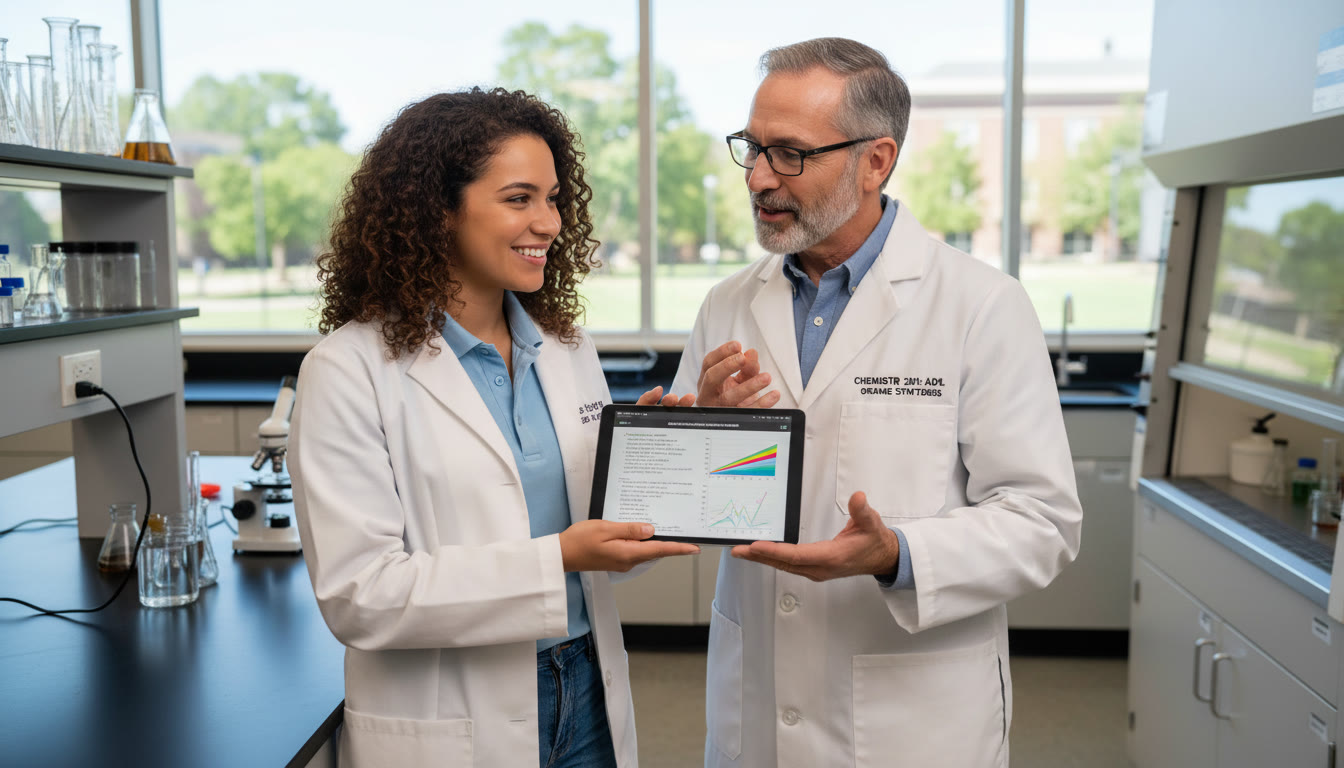Why students and families consider using AP to skip intro college science
It’s an exciting idea: take AP Biology or AP Chemistry in high school, score well on the exam, and show up to college a semester or even a year ahead. For curious students who want to move quickly into upper‑division majors, research labs, or more meaningful electives, earning AP credit can feel like opening a shortcut to deeper learning. For families, the appeal is clear too — potential cost savings, less introductory repetition, and the sense that a child is ready for advanced work.
But the promise of early placement comes with tradeoffs. This post explores the rewards and the risks — not to scare you, but to help you plan realistically and intentionally. We’ll talk about who benefits most, pitfalls to avoid, and practical steps (including how personalized help like Sparkl’s tutoring and AI‑driven insights can support your plan).
What “taking upper‑division bio/chem early” really means
Different colleges accept AP scores differently. At some schools, a qualifying score (often a 4 or 5) can grant you introductory course credit, letting you register for second‑semester or even higher‑level classes right away. At others, AP credit might only place you out of non‑major requirements or provide elective credit that doesn’t affect your major sequence. The net effect is the same: you could bypass basic lectures and labs and enter more focused, advanced courses earlier.

Rewards: Why this path can be worth it
There are several genuine upsides to using AP Biology or AP Chemistry to accelerate into upper‑division courses.
- Faster progression into major‑specific topics. If you’re planning to major in biology, chemistry, biochemistry, or related fields, skipping introductory coursework lets you take specialized electives earlier — molecular genetics, inorganic synthesis techniques, or advanced ecology, for example.
- Earlier research and internships. Upper‑division enrollment often opens the door to lab rotations, faculty research projects, and paid internships that typically prefer juniors or seniors. Getting into those spaces sooner can accelerate your undergraduate trajectory.
- Cost and time savings. Earning college credit in high school can reduce tuition burden, summer course load, or the total number of semesters needed to graduate.
- Academic confidence and momentum. Students who thrive on challenge often find the advanced material more engaging. If you’re bored by large intro lectures, early advancement can renew motivation.
- More schedule flexibility later. Freeing up introductory slots can create space for double majors, study abroad, capstone projects, or heavier research semesters.
Real examples of rewards in action
Imagine Maya, who took AP Biology in high school and scored a 5. At her college, that score satisfied the year‑long introductory requirement. She started sophomore year directly in genetics and joined a lab that needed students with molecular biology basics. By junior year she had two coauthored posters at conferences — an opportunity she might not have had otherwise. Or think of Alex, whose AP Chemistry score let him skip general chemistry and enroll in physical chemistry a semester earlier, enabling a summer internship in materials chemistry between sophomore and junior year.
Risks: What can go wrong and why it matters
Skipping ahead is not risk‑free. The most common problems are academic mismatch, fragile foundations, and missed formative experiences. Let’s unpack these.
1. Gaps in foundational knowledge
AP courses are rigorous, but they compress a lot into a year of high school. College courses — especially those for majors — sometimes assume deeper lab experience, numerical problem solving, or conceptual framing that a high school AP course didn’t fully provide. If the AP course emphasized breadth (many topics) but a college course dives into depth (complex problem solving, math‑intensive analysis), students can struggle to keep pace.
2. Less lab experience and different lab cultures
College labs tend to expect independence: planning multi‑week experiments, maintaining lab notebooks for research continuity, and troubleshooting equipment or protocols. High school labs may teach techniques, but they rarely replicate the iterative, failure‑driven pace of undergraduate research. Students who skip intro labs may miss the chance to practice those soft technical skills.
3. Social and advising mismatch
Being placed into upper‑division classes also changes your peer group and advising context. Introductory classes often come with cohort advising, study groups, and structured support. Jumping ahead can create isolation unless you proactively seek mentoring and peer networks.
4. Transfer and credit policy surprises
Not all AP credit is equal. Some departments will accept AP credit as a direct replacement; others may grant elective credit that doesn’t satisfy major prerequisites. Colleges can change policies over time, too — another reason to verify current rules with the registrar and the relevant department.
How to decide if the reward outweighs the risk: a practical checklist
Not every ambitious student should automatically skip intro courses. Use this checklist to decide, and involve parents, counselors, and your future department advisors.
- Confirm departmental policies. Ask the college’s biology or chemistry department how they treat AP credit for majors. If possible, get the written policy or an email from an academic advisor.
- Compare syllabi. Look at the college’s course descriptions and syllabi for both the intro and the upper‑division course. Are the missing skills (e.g., multistep titrations, differential equations in kinetics, molecular lab techniques) taught explicitly in the intro sequence?
- Assess lab experience. Did your high school AP lab experience include multi‑day projects, independent experimental design, data analysis, and lab notebook maintenance? If not, plan to get that experience through summer programs or research internships.
- Plan a safety net. Identify options to audit or take a supplemental tutorial if you find gaps. Some colleges let you take the intro lab without lecture, or offer bridge workshops during orientation.
- Consider timing. It can be better to use AP credit to skip only non‑major lectures while still enrolling in the lab or the tutorial companion for the advanced course.
- Check the math readiness. For AP Chemistry especially, math skills (algebra, logarithms, calculus basics) are essential. If you’re weak in those areas, postpone skipping until you shore up your quantitative skills.
Decision table: Quick guide for common student profiles
| Student Profile | Typical AP Score | Recommended Action |
|---|---|---|
| Strong lab experience, excellent quantitative skills | 4–5 | Consider skipping intro; enroll directly in upper‑level with lab or seek department approval |
| High AP score but limited lab independence | 4–5 | Use AP for lecture credit but take the intro lab or a bridge lab course |
| Moderate AP score, enjoys structured classes | 3–4 | Take intro college course to build foundations before advancing |
| AP in non‑major school, uncertain policies | Any | Confirm policy with registrar and department; don’t assume automatic placement |
Practical steps to reduce risk and strengthen your candidacy
If you want to use AP credit as a stepping stone, these tactics will increase your chances of success.
1. Get clarity from the department early
Before you enroll, email or call the department advising office. Ask whether your AP score will satisfy major prerequisites or only elective credit. If possible, request permission ahead of registration to join the upper‑division class; departments sometimes allow conditional enrollment if you agree to certain bridge work.
2. Fold in supplementary lab or bridge experiences
Short university summer research programs, community college lab courses, or independent projects with a local college lab can provide the hands‑on experience many students lack. Even a 6–8 week internship can close the most important practical gaps.
3. Build quantitative fluency
AP Chemistry in particular leans on quantitative problem solving. Sharpen algebra, logarithms, and introductory calculus concepts now — targeted practice prevents you from falling behind when thermodynamics or kinetics require multi‑step calculations.
4. Use early office hours and peer networks
Upper‑level classes often assume students will seek help proactively. Schedule regular office hour visits in the first few weeks, join study groups, and connect with teaching assistants. Those early interactions are where you pick up unwritten expectations and grading norms.
5. Consider a hybrid approach
Instead of fully skipping, some students use AP credit to waive the intro lecture but still sign up for the intro lab or for a recitation section. This hybrid route preserves hands‑on experience while freeing schedule space for advanced electives.
How tutoring and personalized support can make a big difference
Going into upper‑division science early is a strategic decision — one that benefits hugely from individualized preparation. Generic study habits won’t always cover the gap between AP and college rigor.
Sparkl’s personalized tutoring can fit naturally into this plan: targeted 1‑on‑1 guidance to shore up weak areas, tailored study plans that align with the specific college syllabi you’ll encounter, and expert tutors who have taught or taken the exact upper‑division courses you want to join. Their AI‑driven insights can track progress and highlight the particular problem types you need to master. In short, high‑quality individualized help reduces the odds that you’ll stumble academically after placement.
What good tutoring should focus on
- Conceptual depth over memorization: drilling the central models and mechanisms so you can apply ideas in new contexts.
- Lab skills and experimental design: practice interpreting raw data, troubleshooting protocols, and writing concise lab reports.
- Math and quantitative problem solving: scaffolded practice from algebra to calculus where needed.
- Exam and time management strategies: how to approach challenging problems in timed settings and how to structure multi‑step solutions.
Common myths and honest truths
There are some persistent beliefs about AP credit that deserve correction.
Myth: A 5 guarantees you’ll be ready for any upper‑division class
Truth: A top AP score is a strong signal, but readiness also depends on lab experience, exposure to college‑level problem sets, and the particular college’s expectations. Think of the AP score as one input — an important one — but not the whole story.
Myth: Skipping intro always saves money and time
Truth: It can, but if you need to take bridge modules, supplemental labs, or remedial coursework later, the financial and time benefits may shrink. Always calculate the real net gain, not just the gloss of “credit earned.”
Myth: You should always skip the intro if you can
Truth: Not necessarily. For many students, the intro sequence provides critical conceptual scaffolding and mentorship access. If the intro course is where you’d be building study skills, lab competence, or networking with faculty, skipping it could slow your long‑term progress.
If you choose to skip: an action plan for the first semester
Assuming you’ve confirmed policy and decided to use AP credit to move ahead, here’s a tactical plan for success in that first crucial semester.
- Week 0: Meet the instructor and TA. Explain your background and ask what they expect students to know coming in.
- Week 1–2: Audit problem sets from the intro course or request a list of recommended review topics. Complete a self‑diagnostic to identify weak spots.
- Week 3–5: Establish a study group and set weekly goals. Visit office hours at least once every two weeks.
- Week 6–10: Take on a small supplemental lab assignment or simulation exercise to practice experimental thinking.
- End of term: Reflect and decide whether to continue in advanced track or take a parallel intro lab or recitation the next term.
Parents’ guide: how to support without overstepping
Parents can play a productive role: help gather policy documents, encourage bridge experiences, and support the search for a good tutor. But avoid treating AP credit as an automatic shortcut — listen to your student’s confidence level and the department’s guidance. If your child struggles early, advocate for bridge resources rather than pushing to stay in a course that’s undermining confidence.
When staying in the intro course makes the most sense
There are many wise reasons to remain in the introductory sequence despite a strong AP score:
- To gain robust lab practice in college‑grade facilities.
- To develop mentorship ties with faculty and TAs who can recommend you for research.
- To consolidate quantitative and conceptual foundations before tackling abstract upper‑division problems.
- To enjoy a more gradual transition to independent academic life.
Final thoughts: a balanced, personalized approach
Using AP Biology or AP Chemistry to accelerate into upper‑division coursework can be a smart move — when it’s intentional. The difference between a smooth transition and a painful misstep usually comes down to planning, honest self‑assessment, and targeted support. Confirm department policies, shore up lab and math readiness, and create a safety net for the first semester.
And remember: help doesn’t mean you’re not ready. Thoughtful, personalized tutoring — whether through guided 1‑on‑1 sessions, a tailored study plan, or data‑driven practice insights — can be the difference between feeling lost in week three and thriving through the final exam. Sparkl’s personalized approach can be especially helpful here: expert tutors align prep to the specific gaps college courses highlight and keep progress measurable and focused.
If you’re a student or parent weighing this decision, start with two conversations: one with the department advisor at your prospective college, and one with an experienced tutor who understands both AP expectations and undergraduate coursework. With the right information and support, AP credit can be a powerful bridge — but only if you cross it with your eyes open.

Quick checklist to take away
- Confirm the college’s AP credit policy with the department.
- Compare syllabi and identify any missing skills (lab, math, experimental design).
- Plan bridge experiences if you lack independent lab practice.
- Consider hybrid enrollment (lecture credit + lab enrollment) when possible.
- Use personalized tutoring to target weak spots and build confidence early.
Need next steps?
If you want, I can help you prepare a short email template to send to a college department or create a 6‑week personalized study plan to bridge AP foundations to college expectations. Tell me which course (AP Bio or AP Chem), your AP score, and whether you want to focus on lab skills, math, or conceptual depth — and I’ll draft a targeted plan.



















No Comments
Leave a comment Cancel